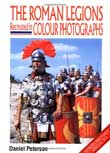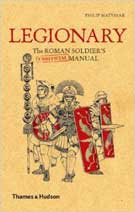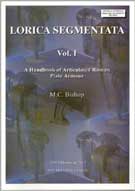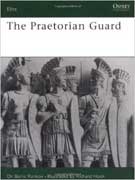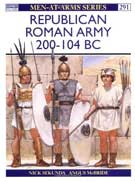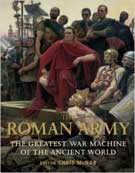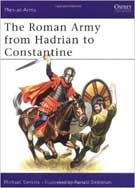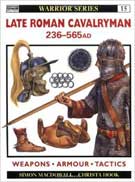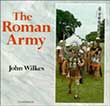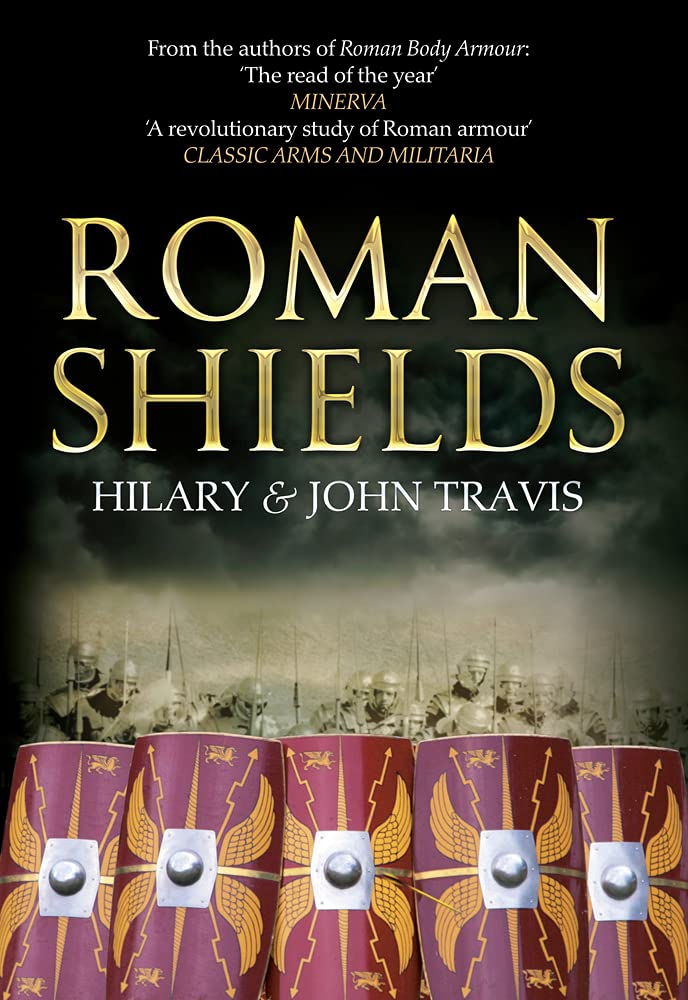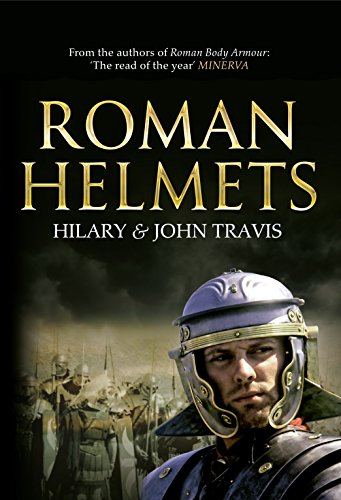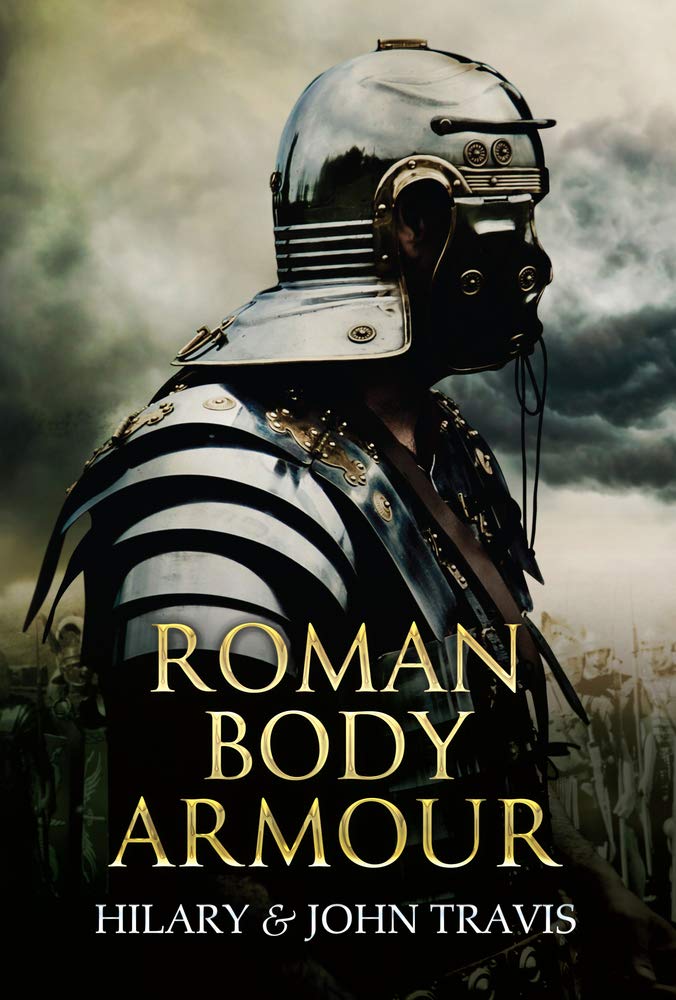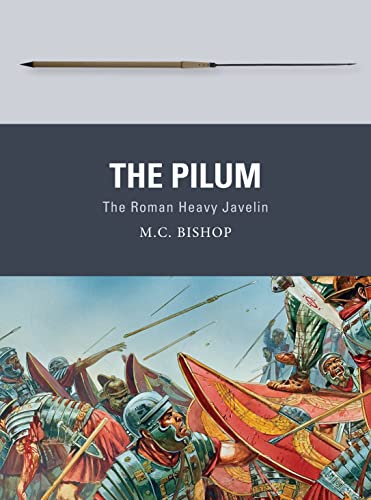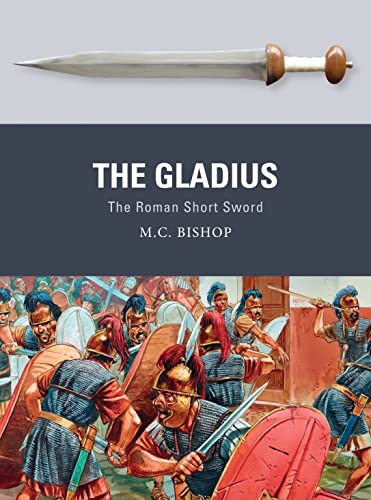

YOU HAVE TO BUY THIS BOOK FIRST!
It is, without a doubt, the best thing for the reenactor to get, as it shows full-color photos of Roman reenactors!
If the movie "Gladiator" shows Roman troops in all their glory on the big screen, "The Roman Legions: Recreated in Colour Photographs" captures all this glory in a book. The photos contained in this book are the marching Roman recreations you see on The Learning Channel, PBS, Discovery, and other educational TV shows. The author, Daniel Peterson, is a military historian and a museum curator and is also the organizer for the largest and most accurate recreations of the Roman military life. He's a member of the world's only authentically reconstructed Roman Calvary unit and in his personifying role has lived, marched, and ridden hundreds of miles across what was once the Roman Empire. His unit is authentically armored and equipped and prepares and eats authentic rations during their outings as Roman Legions. It goes without saying that his book is just as he envisioned it down to the last detail.
Suffice to say, the photos are absolutely stunning! There are hardly any drawings, paintings, or "historical art" in this book; that is all photos of Roman gear and equipment are real replicas and are worn by real humans. Front and back views are presented of Legionnaires, Calvary, Standard Bearers, Centurions, and auxiliary infantrymen. There are plenty of close-ups and detail shots of daggers, helmets, chain main, link plate, shields, and siege engines. Best of all, there are photos showing Legions marching, in formation, defending, and setting up defenses. There are no enemy actors in the photos so someone looking of battle scenes or how Rome's enemies look like will have to use other books.
This book has a brief history of the Roman Empire and also shows gear worn by early (BC) and later (300AD) Romans troops. However, the main focus of this book is showing Roman soldiers at the height of the Roman Empire: 1AD-200AD, or the traditional Legionary and Centurion with the red tunic and chrome plate body armor we often remember.
A great book that puts the information there in an easy to understand, yet humerous manner. Is it deep? No. Is it supposed to be? No. This book DOES, however, impart some really good knowledge about the Legions and their soldiers. And it really is, kind of like a soldier's handbook.
Publisher's description: This carefully researched yet entertainingly unacademic book tells you how to join the Roman legions, the best places to serve, and how to keep your armor from getting rusty. Learn to march under the eagles of Rome, from training, campaigns, and battle to the glory of a Roman Triumph and retirement with a pension plan.
Every aspect of army life is discussed, from drill to diet, with handy tips on topics such as how to select the best boots, or how to avoid being skewered by enemy spears. 15 color, 25 b&w illustrations
THE book to get on the Lorica Segmentata. Well worht it and although pricey, it will help you if you are trying to build a set of this armor.
Publisher's description: This monograph is the first in-depth examination of articulated Roman plate armour since H. Russell Robinson published his ground breaking reconstructions of lorica segmentata in The Armour of Imperial Rome (1975). The book contains a detailed discussion of all the significant evidence including previously unpublished material. Bishop looks at each of the principle types of articulated plate armour, using photographs and drawings of original finds alongside full-sized and specially-prepared computer-generated reconstructions. He examines the strengths and weaknesses of this form of armour, considering a wide range of technical details, as well as practical aspects relating to its reproduction. An accompanying website will provide additional multimedia resources, including colour photographs of original and reconstructed segmental armour, 3D models, video clips, plans, and card models. (100 b/w figures).
The Praetorian Guard of Imperial Rome was the power behind the throne, with the ability to make or break an Emperor. Its origins lay in the guards units of republican commanders and the units of Octavian and Anthony that fought at Actium. This title covers the organisation, dress and history from these early days to the Guard's effective destruction at the battle of Milvian Bridge in AD 312, and also details the guard units of the third and fourth centuries that replaced those lost.
The principal source of information on the Roman Republican Army is the sixth book of the Histories of the Greek historian Polybius, written a little before 150BC. This engaging text by Nicholas Sekunda draws heavily on this vital source to outline the equipment and organisation of the Roman Republican Army from 200–104 BC -- a time when Rome was growing from a regional to a world power. With plenty of photographs and illustrations, including eight vivid full page colour plates by Angus McBride, this fascinating volume examines such topics as the Roman shield, helmets, the cuirass, greaves, the pilum, legion organisation, the principales and the tactics they employed.
The image of the Roman legionary is as familiar today as it was to the citizens - and enemies - of the vast Roman Empire two thousand years ago. This book goes beyond the stereotypes found in popular culture to examine the Roman Army from the first armed citizens of the early Republic through the glorious heights of the Imperial legions to the shameful defeats inflicted upon the late Roman Army by the Goths and Huns. Tracing the development of tactics, equipment and training, this work provides a detailed insight into the military force that enable Rome to become the greatest empire the world has ever seen.As well as describing the changes in the army over the centuries, The Roman Army also sheds light on the talented men who led these soldiers in battle and the momentous battles fought, including Cannae, Pharsalus, and Adrianople. Illustrated with detailed maps, artwork and photographs, this volume provides a complete reference to the Roman Army from the 8th century BC to the period after the fall of the Western Roman Empire in the 5th century AD.
*An older book, but still a good addition to one's library.
Publisher's description: This book is also available with a different cover as "Legions of the North." The year of 122 was the first time a Roman Emperor had set foot in the Province of Britannia since the invasion in AD 43. No doubt he had read many reports concerning the damage caused by marauding tribesmen crossing from what is now Scotland into the Province. Hadrian, therefore, decided - in the words of his biographer - 'to build a wall to separate the Romans from the Barbarians'. This engaging work from author Michael Simkins explores in depth the organisation, equipment, weapons and armour of the Roman Army from Hadrian to Constantine, one of the most exciting periods in Roman history.
The twilight of the Roman Empire saw a revolution in the way war was waged. The drilled infantryman, who had been the mainstay of Mediterranean armies since the days of the Greek hoplite, was gradually replaced by the mounted warrior. This change did not take place overnight, and in the 3rd and 4th centuries the role of the cavalryman was primarily to support the infantry. However, by the time of the 6th century, the situation had been completely reversed. Late Roman Cavalryman gives a full account of the changing experience of the mounted soldiers who defended Rome's withering western empire.
A clear explanation of the organization and structure of the imperial army of about 100 A.D. describes the life of a professional soldier of the Roman Empire, including a typical battle.
Review form Amazon: Though this book is pretty dated, this text is still very accurate in its information. It focuses primarily on the Roman Army under Traianus (Trajan, 98-117) and Hadrianus (Hadrian, 117-138), but makes mention of soldiers and tactics from the 1st-4th Centuries AD. It is a pretty short book, and doesn't waste a lot of time on jargon. It does not really make an attempt to entertain the reader, but at the same time is not dull to read (I read it in less than an hour).
The author summarizes the equipment and recruitment of the legionaries and the auxiliaries, and also takes a useful look at Roman artillery. Included are a useful chart showing the command organization of a legion, and maps showing the main recruitment areas for the 2nd Century Empire. There are a number of black and white photos as well as some interesting and well-done line illustrations of the troops, and the front and back covers both show reenactors of the Ermine Street Guard.
Overall, I would reccomend this book for either a young reader (maybe about 8-14) or an older person who is just now getting their feet wet in the study of the Roman Army. For you veterans of Roman military history, however, this book probably doesn't have anything new for you.
The Roman military is an iconic, ancient institution; everybody is familiar with the image of fearsome Roman soldiers marching in their famous columns. In this book, Roman military experts John and Hilary Travis turn their attention to the shields used by the historic Roman stalwarts, drawing on their expertise, their wealth of illustrated material and the world of re-enactments.In its study of the panoply of shields used by the Roman army, this book differs from those preceding in that it has combined the reams of published information on sculptural imagery and archaeological hard evidence with an in-depth look at the artefacts themselves, their component parts and physical manufacture, going further by reconstructing and subjecting them to regular use in combat conditions.
The Roman military is an iconic, ancient institution; everybody is familiar with the image of fearsome Roman soldiers marching in their famous columns.
In this book, Roman military experts Hilary and John Travis turn their attention to the helmets used by the historic Roman stalwarts, drawing on their expertise, their wealth of illustrated material and the world of re-enactments.
There are currently two different methods in use in the identification of Roman helmet types: the British system, based on developmental progression and features indicating the geographical area of manufacture; and the much simplified Continental system, based on named find locations. In this study of helmets used by the Romans, Roman Helmets draws together the streams of published information of sculptural imagery and archaeological ‘hard’ evidence, while also comparing these dual typologies, discussing their strengths and weaknesses.
This book assesses current views of the body armour used by the Roman army and its development, melding these with the archaeological evidence available.
This book draws together the streams of published information of sculptural imagery and archaeological 'hard' evidence, while also looking at the component parts and how they are physically put together. This has involved a return to basics, in examining wherever possible the original material (as opposed to the published 2-D photographic images and line drawings) and attempting to reproduce the aspects of the artefacts observed through physical reconstruction. The reconstructions produced were then subjected to low-level, simulated wear, over several years, to view component inter-action, and simulated combat/ destructive testing using a range of weaponry, including archery equipment, to view which parts were more susceptible to damage, and what features may be anticipated archaeologically on artefacts as evidence of regular wear, combat damage and field repairs.
Discrepancies were also noted between current reconstructions of Roman military equipment (by museums and re-enactors), which have been produced based on previous desk-based assessments, and the reality of the actual artefacts, particularly in the case of the segmented plate armour (lorica segmentata), which may cause us to re-think not only the appearance, but also the function/fighting methods of the Roman soldier.
An excellent book by noted Roman expert, Mike Bishop. No Roman library should be without this book! If Mike Bishop writes it, you can be sure that there is some really good info in there. And, about the Roman Pilum, a scare subject for a book to be based on. Exciting to see this most important weapon showcased.
A heavy javelin, normally used as a shock weapon immediately before contact, the pilum was designed with a particular specialty: it could penetrate a shield and carry on into the individual behind it. Relying on mass rather than velocity, at short range a volley of pila had much the same effect on a charging enemy as musketry would in later periods. The design was not uniform, with a wide diversity of types throughout the developmental history of the weapon, but for more than four centuries it remained a vital part of the arsenal of weapons at the disposal of the Roman legionary.
Drawing upon recent major finds in the Iberian Peninsula and the Balkans, as well as written records and rigorous scientific analysis, this enthralling study lifts the veil on the evolving nature of the pilum, the Roman heavy javelin that helped to conquer the known world.
An excellent book by noted Roman expert, Mike Bishop. No Roman library should be without this book! If Mike Bishop writes it, you can be sure that there is some really good info in there.
One of the most feared weapons in the ancient world, the gladius was lethal both on the battlefield and in the arena. Literary sources tell of the terror it inspired, while archaeological evidence of wounds inflicted is testament to its deadly effect. By pulling together strands of literary, sculptural, and archaeological evidence, renowned expert M.C. Bishop creates a narrative of the gladius' development, exploring the way in which the shape of the short sword changed as soldiers and gladiators evolved their fighting style.
Drawing together historical accounts, excavated artifacts, and the results of the latest scientific analyses of the blades, this volume reveals the development, technology, training and use of the gladius hispaniensis: the sword that conquered the Mediterranean.
St. Anastasius I ends his reign as Catholic Pope
Seldjuken under Toghril Beg occupy Baghdad
King Henry II of England crowned
Dutch west coast hit by hurricane
Robinson Crusoe leaves his island after 28 years (as per Defoe)
Washington settles his troops at Valley Forge, Pa for winter
English government of Pitt Jr forms
Chinese troops occupy capital Thang Long Vietnam
1st state appropriation of money for road building, Kentucky
Georgia passes 1st US state birth registration law
South Carolina declares right of states to nullify federal laws
HMS Beagle / Charles Darwin approaches New Zealand
US recognizes independence of Hawaii
Charles Dickens publishes "A Christmas Carol, " in England
Allen Wilson of Conn patents sewing machine to sew curving seams
Grading started for Market Street RR
Battle of Black Water
Skirmish at Jackson / Salem Church, Tenn (80 casualties)
Victims of "Angola Horror" burned to death (Angola NY)
Albert L Jones (NYC), patents corrugated paper
Jake Kilrain and Jem Smith fight 106 round bare knuckle draw
Bishop Museum founded in Hawaii
Start of Sherlock Holmes "Adventure of Beryl Coronet" (BG)
1st Negro Catholic priest ordained in US, Charles Uncles, Baltimore
Canadian Rugby Union forms
Williamsburg suspension bridge opens between Brooklyn and Manhattan
Dawson City hockey team begins 9 day walk to get a boat to Seattle to catch a train to Ottawa to play in Stanley Cup on Jan 13 1905
239 workers died in a coal mine explosion in Jacobs Creek, Penn
Gas explosion at Jacobs Creek Pa, coal mine kills 239
1st city ordinace requiring white and black residential areas (Baltimore)
Rayon 1st commercially produced, Marcus Hook, Penn
Jack Johnson fights Jim Johnson to a draw in 10 for hw boxing title
Suriname Bauxite Company forms in Paramaribo
1st NHL game played on artificial ice (Toronto)
Quebec Bulldogs play their 1st professional hockey game
Robert Ripley began his "Believe It or Not" column (NY Globe)
American Meteorological Society found
1st US indoor curling rink opens (Brookline, Massachusetts)
Mrs Theres Vaughn, 24, confessed in court to being married 62 times
1st autogiro (predecessor of helicopter) flight in US
James Weldon Johnson resigns as executive secretary of NAACP
Joseph A Lyons (C) becomes Premier of Australia
British Broadcasting Corp begins transmitting overseas
Electric Home and Farm Authority Inc, authorized
Japan agress to fleet treaty of 1922 and 1930
Russian air and ground attack against Finnish positions near Summa
German submarine U-574 sinks
Hitler takes complete command of German Army
US Office of Censorship created to control info pertaining to WWII
Military coup in Bolivia
Austrian Republic re-establishes
Noel Cowards musical "Pacific 1860, " premieres in London
War breaks out in Indochina as Ho Chi Minh attacks French in Hanoi
2nd political action of Java / Sumatra
8th largest snowfall in NYC history (15.3")
Cleveland Browns beats Buffalo Bills 49-7 in AAFC championship game
Philadelphia Eagles shutout Chicago Cards 7-0 in NFL championship game
Luxury passenger ship Aquitania demolished in Garelock Scotland
WJW TV channel 8 in Cleveland, OH (CBS) begins broadcasting
Gen Eisenhower named NATO commander
Nazi General Christiansen leaves Nethe
Queen Juliana unveals statue "Docker"
KFYR TV channel 5 in Bismarck, ND (NBC / ABC) begins broadcasting
Carl Perkins records "Blue Suede Shoes"
"Music Man" opens at Majestic Theater NYC for 1375 performances
1st Liberty Bowl game-Penn State beats Alabama 7-0
Fire aboard USS Constellation, under construction at Brooklyn (50 die)
Mercury-Redstone 1A reaches 210 km in test flight
British government begins decimal coin system
Indonesian President Sukarno proclaims general mobilization
Nyasaland secedes from Rhodesia and Nyasaland
Street signs in Golden Gate Park approved by Park Commission
Transit 5A1, 1st operational navigational satellite, launched
Zanzibar becomes independent from the UK
French President De Gaulle re-elected (Mitterrand gets 45%)
WCWB (now WMGT) TV channel 41 in Macon, Georgia (NBC) begins broadcasting
"Inner City" opens at Barrymore Theater NYC for 97 performances
CBS airs "Homecoming A Christmas Story, " (introducing the Waltons)
NASA launches Intelsat 4 F-3 for COMSAT Corp
Apollo 17 (last of Apollo Moon landing series) returns to Earth
"Molly" closes at Alvin Theater NYC after 68 performances
Grenada adopts constitution
"Man With Golden Gun" premieres in US
Dave Kryskow scores Washington Capitals 1st NHL shorthanded goal
Nelson A Rockefeller sworn-in as 41st VP
John Paul Stevens becomes a Supreme Court Justice
Ron Wood joined the Rolling Stones
Jo Ann Washam / Chi Chi Rodriguez wins Pepsi-Cola Mixed Team Golf Champ
Piper Cherokee crashes into Baltimore Memorial Stadium upper stands, 10 minutes after Colts lose 40-14 to Steelers. No one seriously hurt
President Brezhnev receives his 5th Lenin order
Dutch government of Van Agt / Wiegel forms
Indira Gandhi ambushed in India
Anguilla becomes a British dependency separate from St. Kitts
Iran requests $24 billion in US guarantees to free hostages
Mutaual Broadcasting cancels Sears Radio Theater
China PR Premier Zhao Ziyang and Margaret Thatcher sign Hong Kong Treaty
Fire at Wilberg Mine in central Utah killed 27 people
UK signs agreement with China to return Hong Kong to China in 1997
Wayne Gretzky, 23, is 18th andyoungest NHL-er to score 1,000 points
"Wind in the Willows" opens at Nederlander Theater NYC for 4 performances
Mary Lund is 1st woman to receive a Jarvik VII artificial heart
STS 61-C scrubbed at T -13s because of SRB auxiliary power problem
Jack Morris agrees to salary arbitration with former team Tigers and accuses owners of collusion against free agency
Michael Sergio, who parachuted into Shea Stadium during game 6 of the World Series, sentenced to 100 hours of community service and fined $500
USSR frees dissident Andrei Sakharov from internal exile
Gari Kasparov becomes world chess champ
NASA unviels plans for lunar colony and manned missions to Mars
Unexploded WWII bomb found in Frankfurt, Germany-5,000 evacuated
Larry Bird (Celtics) begins NBA free throw streak of 71 games
6,000th episode of One Life To Live
Boris Yeltsin takes control of Kremlin
New York Yankee pitcher Steve Howe arrested for cocaine possession
"Red Shoes" closes at Gershwin Theater NYC after 5 performances
Guinee general Lansana re-elected President
Queen Elizabeth askes Prince Charles and Diana to divorce
"Once Upon a Matress, " opens at Broadhurst NYC for 187 performances
MTV drops video "Smack My Bitch Up" by Prodigy
